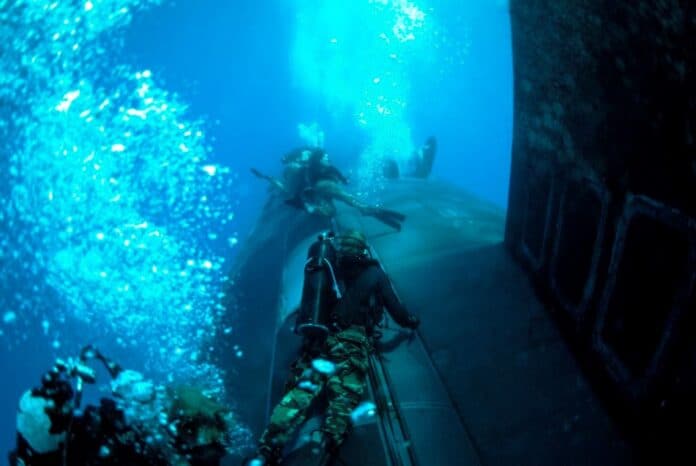The Virginia-class submarine USS New Mexico (SSN 779) concluded interoperability training with embarked Navy SEALs in the Mediterranean Sea, June 30, 2021.
According to a press release issued by the U.S. Navy, this milestone event, and proof of concept in theatre, demonstrated the ability for submarines to seamlessly integrate SEALs into Navy missions in the U.S. Sixth Fleet area of operations to ensure global access, security, and stability in the maritime domain.
“The combined clandestine capabilities of Naval Special Operations Forces and submarines provide an asymmetric advantage that bolsters the Navy’s lethality from the sea,” said Rear Adm. Anthony Carullo, Director of Maritime Operations, U.S. Sixth Fleet and Commander, Submarine Group 8. “This training demonstrated how the submarine force can adapt mission sets for theatre commanders, providing a variety of options to address multi-domain challenges.”
While underway, New Mexico’s crew and embarked SEALs rehearsed command and control architecture, staged equipment, and conducted diving operations utilizing the submarine large lock-in/lock-out chamber.
“Special Operations Forces (SOF) are most effective when well integrated with our joint partners,” said Air Force Col. William Freeman, operations director for Special Operations Command Europe. “Close coordination between SOF and conventional forces is a force multiplier and leverages discreet special forces capabilities, such as the skills on display in Crete between our SEALs and USS New Mexico.”

New Mexico is homeported in Groton, Conn. and is executing a routine deployment, conducting maritime security operations with allies and partners in the U.S. Sixth Fleet area of operations. Early this year, New Mexico conducted a scheduled logistics visit to Tromso, Norway, during operations in the High North and participated in exercise Ragnar Viking. Ragnar Viking is a multilateral operational exercise that exhibits high-end NATO cohesion, solidarity, and credibility in the Norwegian, North, and Baltic Seas. The exercise demonstrated long-range strike capabilities from the North Atlantic into Lithuania, amphibious landings in Norway and anti-submarine warfare (ASW), and surface action group operations to control the sea, air, and undersea domains, while projecting power.
Demonstrating another increased capability in the region, Sailors aboard the Los Angeles-class submarine USS Montpelier conducted an expeditionary ordnance on-load in Souda Bay, Greece, exercising the capability to load the MK 67 submarine-launched mobile mine, June 22. Conducting an on a load of this type, from Souda Bay’s strategic location in the Eastern Mediterranean, enables submarines to replenish or perform maintenance on their payloads while executing missions at sea.
“This capability provides submarines more time on station,” said Capt. John Craddock, Commander, Task Force 69. “Previously, submarines may have had to travel much farther, now they can conduct an on load in the region and relocate quickly to the waters in and around Africa and Europe.”
Submarines in U.S. Sixth Fleet work together with U.S. Navy, allied and partnerships and aircraft to provide multi-domain security and stability. The Los Angeles- class submarine USS San Juan (SSN 751) joined a P-8A Poseidon maritime patrol reconnaissance aircraft, Arleigh Burke-class guided-missile destroyer USS Donald Cook (DDG 75), and the French Charles De Gaulle Carrier Strike Group to participate in NATO Allied Maritime Command-led exercise Dynamic Manta in the Mediterranean Sea, Feb. 22-March 5. During the exercise, participants conducted anti-submarine and anti-surface warfare evolutions in a simulated multi-threat environment in order to improve allied cohesion and deter adversaries.
“Dynamic Manta allowed San Juan to operate as part of the Allied theatre ASW team,” said Cmdr. Douglas Sattler, commanding officer of San Juan. “The maritime domain is too large and too complex for any one nation to safeguard, we truly value the opportunity to increase collective readiness with our NATO Allies and partners.”
Check out Naval Library App to learn more about the specifications of Virginia class submarines.





